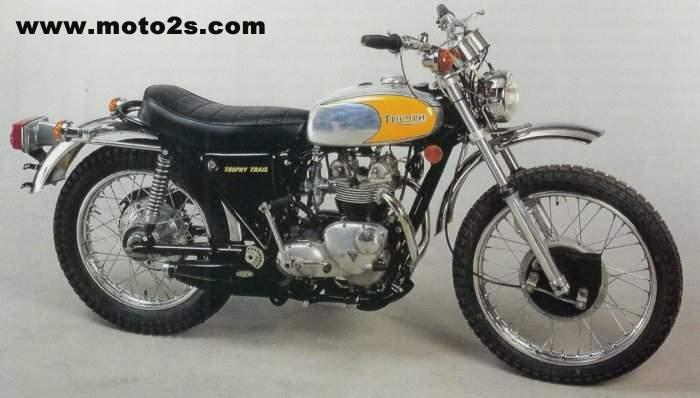Triumph TR5T Trophy Trail 500 
The Triumph TR5T Trophy Trail 500 isn’t a serious motorcycle, but that doesn’t mean it’s a bad motorcycle, either. The TR5T was built just to be a cheerful little number that could fill a niche in the market. Lightweight, with a good engine and an adequate chassis, it wasn’t a motorcycle intended for serious competition, but more a cycle built as an entertaining play-bike for those with hundreds of miles of forest roads or black-topped one-laners to ride.
In its day, the TR5T was quite the opposite of those great, honking 650cc desert sleds that were so popular in the scrub-lands of California and Arizona; this was an East Coast special, intended for more leisurely pursuits in the Berkshire Hills of Massachusetts or the Shenandoah Mountains of Virginia.
How we got here
In the early 1970s, the engineers at Triumph were trying to spiff up their line of models at the lowest cost possible, since Triumph was having severe financial problems. Triumph had been partnered with Birmingham Small Arms (BSA) for over 20 years, with the two brands kept very separate until the late 1960s, when the British motorcycle industry started collapsing with barely a whimper. At the Meriden factory, workers began cobbling together bikes by picking and choosing from the Triumph and BSA parts bins, and in 1971 some enterprising worker realized that with a few minor modifications, the Triumph 500cc engine could be fit into the new BSA scrambler-type frame.
The U.S. had always been Triumph’s best market, but sales of the high-piped street-scrambler T500C models had dropped off, thanks to cheaper Japanese machines. However, the marketing suits at the Meriden factory figured that a Triumph-powered woods bike might have good sales potential, so they built one.
Introduced for the 1973 model year, the Trophy Trail was known as the Adventurer in the U.K. Rumor had it that the Trophy Trail was, in truth, a tribute to the 1973 International Six Days Trial (ISDT) that was being held in the U.S. This was the first time since 1913 that the ISDT had a venue outside Europe. This new model was not intended to go up against ferociously focused machines put forth by outfits like Jawa, Husqvarna and John Penton, but would be the layman’s version, giving the image of derring-do while offering a modicum of comfort.
The ISDT was originally intended to be a reliability event, with the motorcycles running for six days, and repairs could only be done by the rider with tools he carried. This made a great deal of sense back before World War I, as roads were in pretty rough shape. After the end of World War II the event had been altered to fit a more modern format, with the course being run mostly on dirt roads and trails, with a bit of pavement in order to keep everybody honest as to lights and braking. Many manufacturers took winning deadly seriously, but not the boys designing the TR5T. |
